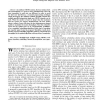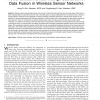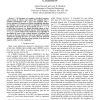TPDS
2008
14 years 3 months ago
2008
Communication is a primary source of energy consumption in wireless sensor networks. Due to resource constraints, the sensor nodes may not have enough energy to report every readin...
CACM
2005
14 years 3 months ago
2005
them as an abstract cellular model where users access information through access points. ract model consists of a base station, a number of clients, and a number of channels. A cli...
TCOM
2008
14 years 3 months ago
2008
Abstract In multiuser MIMO systems, the base station schedules transmissions to a group of users simultaneously. Since the data transmitted to each user are different, in order to ...
IJSNET
2007
14 years 3 months ago
2007
: Most wireless ad hoc sensor networks are susceptible to routing level attacks, in which an adversary masquerades as a legitimate node to convince neighbouring nodes that it is th...
SIGMETRICS
2008
ACM
14 years 3 months ago
2008
ACM
We consider a wireless collision channel, shared by a finite number of mobile users who transmit to a common base station using a random access protocol. Mobiles are selfoptimizin...
JCM
2006
14 years 3 months ago
2006
One of the most common communication patterns in sensor networks is routing data to a base station, while the base station can be either static or mobile. Even in static cases, a s...
JSAC
2008
14 years 3 months ago
2008
We consider a wireless collision channel, shared by a finite number of users who transmit to a common base station. Each user wishes to minimize its average transmission rate (or p...
CORR
2007
Springer
14 years 3 months ago
2007
Springer
—Wireless sensor networks place sensors into an area to collect data and send them back to a base station. Data fusion, in which collected data are fused before they are sent to ...
IJSNET
2008
14 years 3 months ago
2008
Abstract: We present PERT, a power-efficient scheme to deliver real-time data packets in sensor networks. Time-sensitive sensor data is common in applications such as hazard monito...
CORR
2006
Springer
14 years 3 months ago
2006
Springer
1 In this paper, we consider a downlink communication system, in which a base station (BS) equipped with M antennas communicates with N users each equipped with K receive antennas....



